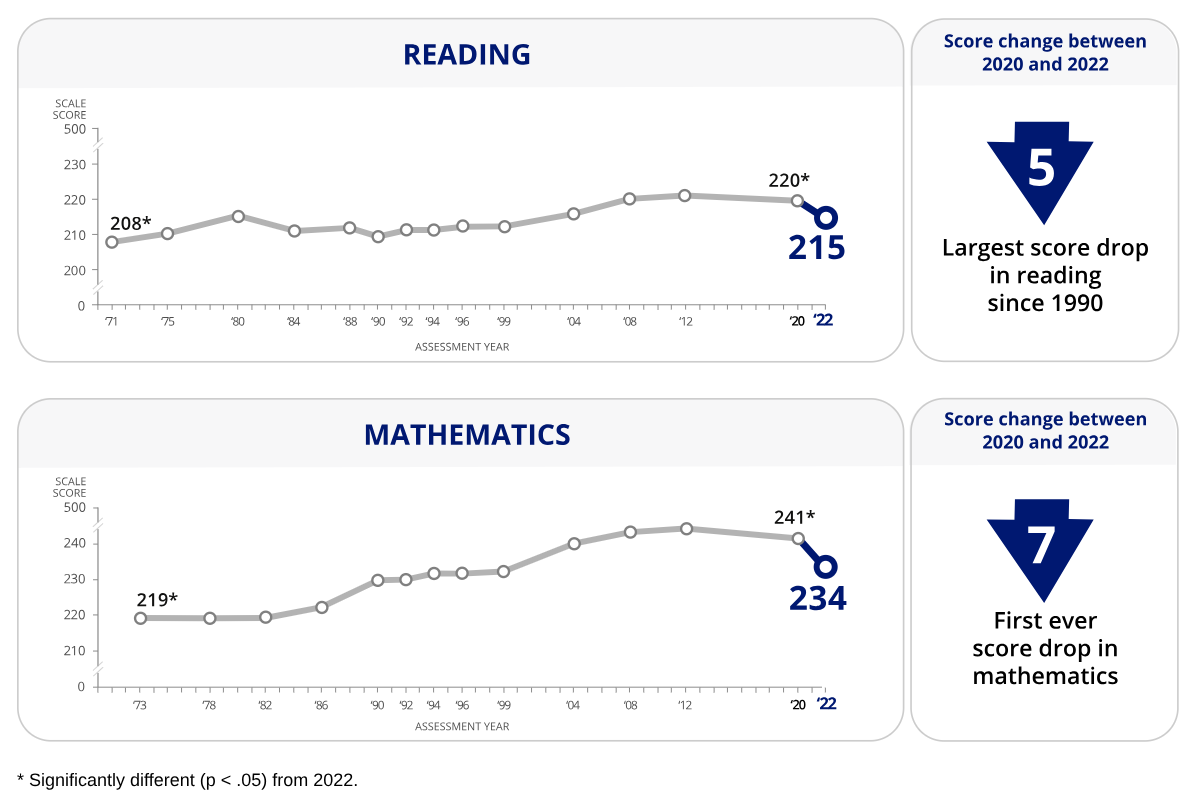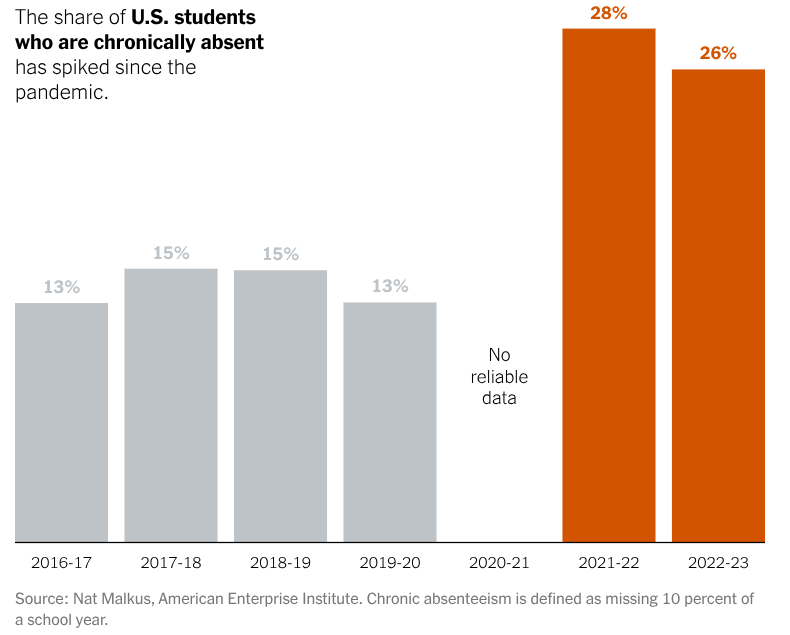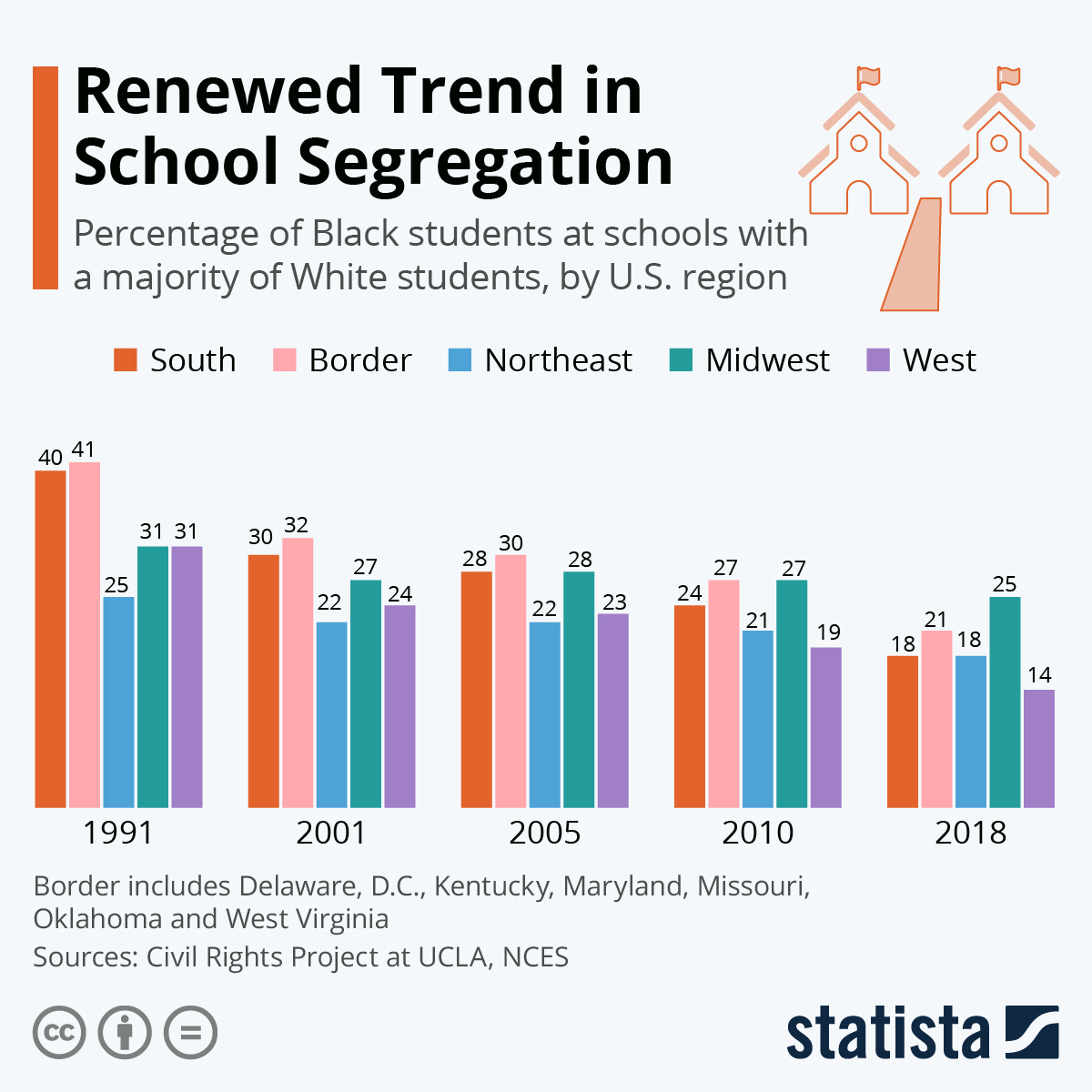5 Hard Truths Democrats Must Face on Education
What is the state of America’s K-12 schools, and where we go from here?
Last Friday, I watched my students walk out of my classroom for the last time. After we talked about summer plans, shared memories from the school year, and said our goodbyes, the final bell finally rang, and I went back to my desk to finish grading projects, papers, and presentations (and of course, a healthy amount of late work turned in at the last possible second). Looking out the window at the kids rushing off to get in their cars and head to Culver’s, the beach, or a friend’s house, I reflected on how lucky I was to have such amazing (if sometimes squirrely) students, to have a job in which I feel that I’m making a difference every day, and to teach at a good school that pairs high expectations with high support.
However, it was impossible not to worry about what the future will look like for my students outside the four walls of our school, and to wonder what could be done about the slow crisis afflicting American K-12 schools: students fell behind and remain behind after COVID, we have a growing national teacher shortage, and our school system is more unjust and unequal than at any point in the last sixty years.
But amidst all the bluster about billionaires and borders and Big Beautiful Bills, there is surprisingly little national discussion about the struggles facing our schools. Republicans insist that culture wars and school sports are the most pressing issues. Instead of solving real problems in our schools, they are focused on tearing down educational institutions, from the Department of Education to American universities. Yet, as an indictment to Democrats, Americans increasingly trust the Republican Party over Democrats on education.
With their handling of school closures and the pandemic, Democrats created an opening for Republicans to be the party that pledged to empower parents. Now, having lost the White House and Congress, Democrats have focused on opposing President Trump’s assault on the Department of Education. They seem to have remembered how deeply Americans care about their children’s education, but it’s not at all obvious that parents care about the Department of Education.
The truth is the problem for Democrats on education goes further back than the pandemic and deeper than the culture wars. Students are struggling, teachers are leaving, and schools are becoming more segregated and unequal. As any teacher, parent, or student knows, our schools desperately need help and change. To regain the trust of Americans on education, Democrats need to propose solutions to these challenges, not just glom on to the latest Trump headline or defend a distant Washington bureaucracy.
This summer, I will write a few pieces proposing some “Wicked Good Education Policies.” But first, we must confront five hard truths about the state of U.S. schools in 2025 that Democrats have willfully ignored to the detriment of our kids. Changing these realities must be the North Star of the next President and Secretary of Education, and policymakers at all levels of government nationwide.
1. Students stopped learning during COVID, and we’ve failed to help them catch up.
During the pandemic, U.S. students’ reading and math skills dropped more sharply than in any single year since we started measuring them. Five years later, they have still not recovered; in fact, reading scores have dropped even further since 2022.
The pandemic hit poor students and students of color especially hard. Decades of progress in reducing the racial and economic achievement gaps was erased in less than two years, despite the fact that extra federal school aid mitigated the damage a little bit in poor districts. Instead, the racial and economic achievement gaps in math have continued to widen since the pandemic.
On several occasions, I have asked my students if they felt they had learned anything during pandemic-era “remote learning,” and the answer has always been a resounding and unanimous “No.” In hindsight, it is clear that many schools remained closed for longer than they needed to, that this disproportionately hurt the vulnerable students that Democrats claim to fight for the most, and that Democrats bear a lot of responsibility for this failure.1
2. Democrats have responded to post-COVID learning loss by lowering the bar.
Rather than confronting COVID learning loss head on, Democrats in charge of schools at the local and state level have too often responded by lowering the bar. Even the term “learning loss” has become frowned upon by some Democrats and educators. Cecily Myart-Cruz, president of the LA teachers union, said in 2021 that, “There is no such thing as learning loss. Our kids didn’t lose anything. It’s OK that our babies may not have learned all their times tables.”
Most liberal education leaders haven’t been as blunt as Ms. Myart-Cruz, but many have given in to a quieter version of denial. Here in Wisconsin, the Superintendent of Public Instruction is technically a nonpartisan statewide elected official, but the current state superintendent Dr. Jill Underly is a Democrat. Like every state, Wisconsin saw historic learning loss during the pandemic, and our students still have not recovered. You might expect that Dr. Underly would propose a bold strategy to address this crisis. Instead, she lowered the benchmarks for proficiency in reading and math on the statewide Forward exam, and even removed the terms “proficient” and “below basic” from the Forward test results. Even Democratic Governor Tony Evers initially criticized the changes, but this spring every Democrat in the state legislature voted “No” on a bill to repeal the lower benchmarks, and Mr. Evers vetoed it.
The tyranny of low expectations has taken hold in schools across the U.S. Reading and math scores have fallen, ACT scores are at a 30-year low, just 37% of high school seniors are proficient in reading, and as many as 1 in 5 U.S. adults are “functionally illiterate.” Yet the average high school GPA and graduation rate have both risen significantly in recent years.
Every semester, I struggle to motivate struggling students in my high school classes because they know that it is impossible to fail a class or get held back. They know that they can just attend the summer credit recovery program at our school and supposedly “learn” an entire semester or school year’s worth of content in a few weeks. It’s no wonder that school absenteeism has skyrocketed since the pandemic. Students have realized that they can pass their classes and get a diploma without actually being in class.
Instead of burying our heads in the sand, Democrats need to wake up and realize that lowering the bar until it’s already met is not an option. It’s not serving our kids, and it’s not what schools are supposed to do.
3. We are losing our best teachers, and nobody seems to care.
Since the pandemic, it has become increasingly common for liberals to bash teachers unions, but these critics are typically silent on how we are going to recruit and retain new teachers without competitive pay and benefits, collective bargaining rights, and basic professional respect and appreciation. In 2019, 50% of teachers said they had seriously considered quitting teaching in the past few years - in the wake of the pandemic, that figure has risen to 78% in 2025. Our schools can’t function without teachers, and Democrats need to listen to teachers and work with them to address the nationwide teacher and the broader crisis afflicting the teaching profession.
We have a nationwide teacher shortage in large part because we are failing to keep teachers in the classroom. Fifteen years ago, about 1 in 5 new teachers were leaving the profession within their first 5 years, but today that figure is nearly 1 in 3. To make matters worse, lots of veteran teachers retired early during the pandemic. This was a massive loss given that, on average, teachers become more effective the longer they are in the classroom.
The teacher shortage has gotten so bad that many states are simply lowering the bar, allowing people into classrooms without teaching certificates or even any formal teacher training. In 2021, 1 in 5 new teachers in Texas were allowed to skip the usual certification process, and some states have even ordered National Guard soldiers to serve as substitute teachers!
4. Public schools are just as racially segregated and unequal today as they were in 1954 (and the problem is worse in the North and in blue cities).
In history class, we all learned about Brown v. Board of Education of Topeka, the famous 1954 Supreme Court case in which 9 year-old Linda Brown convinced the Supreme Court to unanimously declare that school segregation was unconstitutional. That’s usually where the history lesson ends, and we all give ourselves a self-satisfied pat on the back. And yet, in 2025, the stark reality is that America’s schools are not only just as racially unequal as they were 61 years ago, they’re also just as racially segregated.
U.S. public schools desegregated rapidly in the ‘60s and ‘70s, and then more slowly in the late 20th century. As they did so, students of color saw big gains: Black high school graduation rates and post-graduation incomes increased, and the Black-White achievement gap in reading and math decreased. But around the turn of the century, the arc of the moral universe bent back towards injustice.
According to the Stanford Segregation Explorer, Black-White school segregation increased by 35% from 1991-2020, and economic school segregation increased even more (47%) over the same 30-year period. Seventy years after Brown, schools attended predominantly by students of color are still afflicted by many of the same tangible differences between segregated schools that existed in 1954—less per-pupil spending, larger class sizes, crumbling and unsafe school facilities, fewer certified teachers, and fewer opportunities to take advanced courses that will prepare them for college. The Black-white achievement gap in reading and math was larger for students born in 2001 than students born in 1976. The Black and Hispanic college attendance rate peaked fifty years ago.
Schools in blue states and cities are actually more segregated and more unequal than in red ones. New York has the most racially segregated schools in the U.S., and California comes in second place. Barring a few outliers, all of the most segregated school districts in the country—Chicago, Detroit, New York City, Los Angeles—are anchored in blue cities and run almost exclusively by Democrats at both the local and state level. The failure of Democrat-run schools to offer equal opportunities to their students of color is contributing directly to the last hard truth that Democrats must face on education…
5. Many students of color and working-class kids are attending failing schools, and their parents increasingly blame Democrats.
In the 1970s, Charlotte was considered a national model of effective busing and school desegregation. However, following a series of policy changes and court decisions in the 1990s, the Charlotte-Mecklenberg Schools (CMS) rapidly re-segregated. Today, CMS is the most racially segregated school district in North Carolina, saw severe learning loss during COVID, and has seen its Black, Hispanic, low-income, and multilingual students suffer disproportionate declines in reading and math scores since 2020.
Public schools are supposed to be engines of social mobility, but Charlotte ranks dead last among the 50 largest cities in the country in its record of helping poor kids escape poverty. The hard truth for Democrats? Eight of the nine current CMS school board members are members of the Democratic Party.
In many states and communities, schools run by Democrats are failing, and people of color and working-class families are taking notice. Sixty percent of parents of school-age children give their local public schools an A or B grade, but that figure is over 70% for white and Asian parents and below 50% for Black parents. Those perceptions are starting to hurt Democrats at the ballot box.
Wisconsin can offer a recent example. In April 2025, Wisconsin held an election for State Supreme Court and State Superintendent of Public Instruction. Susan Crawford, the de facto Democratic candidate for Supreme Court, defeated her Republican opponent with 55% of the vote. Dr. Jill Underly (the incumbent state superintendent who lowered the bar for proficiency in math and reading) ran 2 percentage points behind Ms. Crawford.
The local-level results are more revealing. In Milwaukee County, Dr. Underly’s margin of victory was 16 points smaller than Ms. Crawford’s. Dr. Underly also ran 7 points behind Ms. Crawford in Dane County (Madison) and 3 points behind her in Brown County (Green Bay). Those counties all contain majority-minority urban school districts that have experienced larger-than-average declines in reading and math scores in the past five years, and those school districts are all run by Democrats. A Democrat has been the Wisconsin Superintendent of Public Instruction since at least 2009, and Wisconsin has had the widest Black-white achievement gap in the nation for virtually that entire time period.
Many Democrats (especially white, educated, affluent Democrats who are able to send their kids to good schools) seem to be willfully ignorant or indifferent towards the cruel realities that exist in too many public schools. Democrats cannot afford to take voters of color for granted or ignore their growing and justifiable doubts about our education policies. We must offer real opportunity to families and children who for too long have had too little.
In future installments of this series on Wicked Good Education Policies, I will explore potential policy solutions to these problems. My goal here is to make my fellow Democrats uncomfortable in confronting the crisis in American education head on, and challenge Democratic policymakers to be bold in solving it. As I often tell my students, “If you want to learn and grow, you need to get comfortable with being uncomfortable.”
Evan Bonsall is a lifelong Midwesterner and is passionate about education, housing policy, city planning, and economic justice. A proud “Yooper” (i.e., a native son of Michigan’s remote Upper Peninsula), he previously lived in Marquette, Michigan, where he worked as a planner, educator, and the youngest-ever member of his local city council. Evan and his wife Aubrie now live in Wisconsin, where Evan works as a high school social studies teacher. He has been a K-12 classroom teacher for three years, and is an active member of his teachers union. Evan earned an A.B. in Government from Harvard University in 2019, and an M.A. in Education from Northern Michigan University in 2022.
Reasonable people can disagree about the extent to which remote and hybrid school were necessary, how they could have been better-executed, and precisely how long they should have continued. But the data clearly shows that remote learning was hardly better than skipping school altogether. A 2023 analysis by Harvard and Stanford researchers found that U.S. students lost a full school year’s worth of learning in reading and a semester’s worth in math, with some large school districts seeing up to 1.5 years’ worth of learning loss. Perhaps most worrying, the same report projected that this learning loss would become permanent unless “schools and parents expanded learning time this summer and next [school] year” (Spoiler: They didn’t).






I’ve lived in a diverse, inner-city Milwaukee neighborhood for over 30 years and want to say that my neighbors and I, of all colors/cultures, are deeply concerned about the way the education available to students dependent on public schools is increasing NOT getting the job done. Maybe it is good that COVID has focused attention on the seriousness of the situation. Our kids can do great things if properly challenged and supported; some of our public schools do this but it is critical that they ALL do so — the world’s future literally depends upon it.
From Al Green to Alex Padilla
Why are elected officials performative-cosplaying to protect criminals? Why don’t Democrats stand up for Americans for once? https://torrancestephensphd.substack.com/p/from-al-green-to-alex-padilla